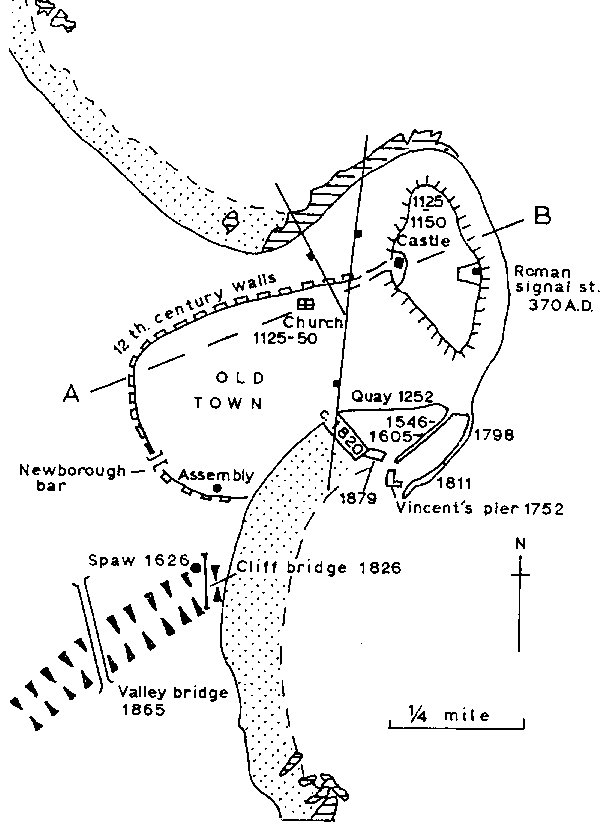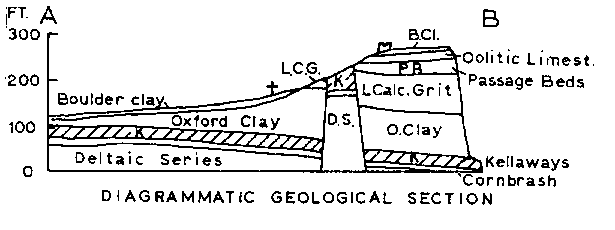The geological basis of a town's development.

Scarborough- Castle Hill from the south.
for a streetmap of Scarborough go here
Scarborough is dominated by Castle Hill, a promentory rising to nearly 100m above
sea level. On either side of Castle hill the cliffs are relatively low. Sandy
beaches run north and south.
The Site is a perfect natural defensive position and
the headland was the site of an iron age fort from approtely 700-400 B.C., one of
the most northerly of its type in Britain. The hill was the sight of a Roman signal
station (370 A.D.). The town was founded in A.D.967 by scandinavians, the name
deriving from Skarthaborg or Scartheburg, the stronghold of Skarth the Harelipped.
Later the Normans erected a
castle,
substantial remains of which remain. The
Normans utilised the fault line running across the headland to build a great
defensive ditch before the outer walls were built in the twelth century.
The headland creates one of the few natural harbours between Whitby and the Humber,
providing protection from storms from the north and north-east. A quay was built
on the southern side as early as 1252. Many piers creating an enclosed harbour
were built subsequent to this.
In 1626 the "Spaw Well" was discovered with reputed medicinal qualities. This lead
to the development of Bridlington Spa. Before the end of the seventeenth century the
town had become established as a fashionable watering place for the well-to-do.
In 1845 a rail link to York was completed making use of the glacial meltwater
channel south of the town and the flat land on the south side of the Vale of
Pickering, the floor of an impounded glacial lake. Later road links followed the
same route. With easy transport links established tourism rapidly developed.
With its sandy beaches Scarborough, along with Bridlington became a major holiday
resort. To this day
tourism is the major industry of the town though it continues to support a small
fishing industry.
To the north and south of the headland are sandy beaches. North of Scalby mills, the northern end of north bay the coastline changes to high cliffs with an extensive wave cut platform. This platform, cut in sandstones laid down in a deltaic environment show paleo-channel structures North of Scarborough there are no more sandy beaches until north of Whitby. Southward with the exception of Cayton Bay there are no accessable sandy beaches until Filey is reached.
The headland is now protected by the sea wall of 'marine drive' and from here the slope of oxford clay is seen with many fallen blocks from the beds above. A fault has brought the underlying Kellaways formation to sea level and this resistant rock has created the headland. From north bay the fault can be clearly seen on the northern side of Castle Hill running obliquely under the castle. In plan the fault is Y shaped.



The Kellaways Rocks are hidden beneath the breakwater, road and funfair of marine drive to the right of the picture. The breaks in slope profile show the bare face of the Oxford Clay. Above this the Saintoft member of the lower calcereous grit is a tough calcereous sandstone. The Passage beds here consists of 1.5m of fine to medium grained shelly sandstone followed by 7m of alternating silty clays and shelly limestones. This passes into the overlying Hambleton Oolite which is massively bedded just below the castle walls. Finally the sequence is covered by a thin layer of Glacial Drift.
It was at Scarborough that in 1825 Willian Smith, aged 56 fell while climbing to measure the dislocation of the fault. The fall resulted in paralysis of his legs and nearly ended his career as a geologist, a salutory lesson to us all to take care during field trips
return to the East Yorkshire Geology and Geomorphology homepage